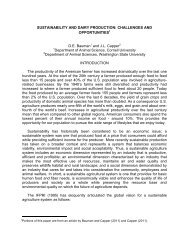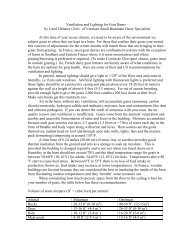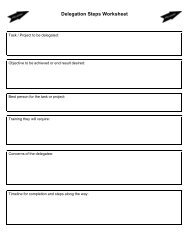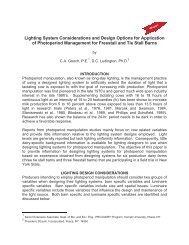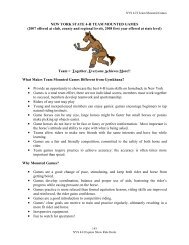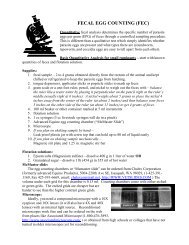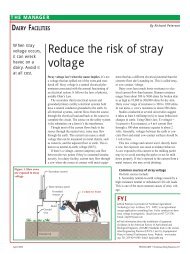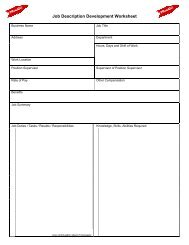NEW YORK STATE 4-H MEAT GOAT PROJECT - Cornell University
NEW YORK STATE 4-H MEAT GOAT PROJECT - Cornell University
NEW YORK STATE 4-H MEAT GOAT PROJECT - Cornell University
You also want an ePaper? Increase the reach of your titles
YUMPU automatically turns print PDFs into web optimized ePapers that Google loves.
<strong>NEW</strong> <strong>YORK</strong> <strong>STATE</strong> 4-H<br />
<strong>MEAT</strong> <strong>GOAT</strong> <strong>PROJECT</strong><br />
FACT SHEET #5<br />
By Dr. tatiana Luisa Stanton<br />
April 1999<br />
<strong>Cornell</strong> <strong>University</strong>, Ithaca , NY 14853<br />
FACILITIES FOR YOUR MARKET WETHER<br />
Please note - If you have a meat goat breeding stock project, read NY 4-H Dairy Goat Fact Sheet #5 as well<br />
because you will be keeping your goats in the winter and housing newborn goat kids.<br />
Housing - Market wethers are easy to house because you do not own them during the coldest months of<br />
the year. In a pinch even a 3 ft square wooden shipping crate or a dog house for a very large dog makes a decent<br />
home for one wether. Whatever shelter you use should have a dry, well drained floor and protect the goat from rain<br />
and severe winds. It should have easy access to water, be easy to put bedding in and easy to rake up and remove<br />
soiled bedding from. Use straw bedding, changed regularly, if your goat’s shelter is a doghouse or shipping crate<br />
Locate your goat house far enough from your house that normal goat noises and flies will not bother your family but<br />
close enough that you will hopefully hear if your goat gets attacked by dogs.<br />
One of the simplest, cheapest shelters to build is a 3- sided shed. The open side of the shed should face<br />
South unless this is the direction your worst storms come from. The roof of the shed should slope away from the<br />
open side so rain and snow will slide off to the back rather than making the shed wet at the opening. Locate the<br />
shed where there is good drainage. Putting a few inches of gravel on the floor or laying down some old wooden<br />
pallets will aIso help keep the ground dry inside. The dimensions of the shed should provide a minimum of 12 to 15<br />
sq. ft. of floor space per wether assuming he also has a yard to exercise in. For example a shed that is 6 ft long and<br />
4 ft. wide can house two wethers. The shed should be a minimum of 3 ft high at the back and anywhere from 44<br />
inches to 6 ft tall at the front. A taller shed will tend to be draftier, which is an advantage in the summer but a<br />
disadvantage in the winter. If you make the shed tall enough for you to stand up (for example 4 ft. at the back and 6<br />
ft at the front), you will be able to tie your goat in it when you are brushing him and trimming his hooves, etc. If<br />
the wether is very young or the weather is cold, it is a good idea to board up half the front of the shed to form a 3<br />
1/2 sided shed to give the goat more weather protection.<br />
Larger sheds, barns and garages can also be used for goat housing. The advantages of these larger<br />
buildings is that you can often arrange them so that you have one stall to keep your goats in and one stall to store<br />
their feed and equipment in. You must make absolutely sure your goat can not break into your feed area. Goats do<br />
not use common sense and are easily killed by overeating grain if they get into a loose sack of it. Make sure glass<br />
windows are not situated where bored goats can reach and break them. Cement floors are not necessary and should<br />
be covered with 6 inches of bedding to soak up urine and manure.<br />
Pens - As well as a shed your goat will need a pen to exercise in. Remember, he needs to build a lot of<br />
muscle to have a good meat carcass. Goat pens should be easy to keep goats in and dogs out and provide at least<br />
25 sq.ft. of floor space per goat. If possible they should be even larger so that your goats can race around and kick<br />
up their heels and really exercise if they want to. One of the simplest but not necessarily cheapest pens to build is to<br />
make a 16 ft square pen using 4 - 6 ft.high steel fence posts (driven 1 1/2 ft. deep) and 4 - 16 ft. long metal livestock<br />
panels. The panels can be wired to the posts except at one corner where two sided snaps can be used instead to<br />
provide a gate<br />
Another ideal fencing for pens is woven net wire fencing at least 42 and preferably 48 inches hign. An<br />
ideal woven fence has a small mesh size at the bottom and gets larger at the middle and top. Ideally, you want the<br />
mesh to be at least 8 inches wide at the top so that your goat can not get his head hung in it. Welded wire fencing<br />
tends to break at the welds after a year of goats repeatably standing on it, but can be used if a strand of electric wire<br />
is run about 4 inches in from it at the top (use “offset” plastic insulators) to discourage goats from leaning on it.<br />
Electric wire fences alone are tricky since at least a few times a year you can count on them malfunctioning and
losing their charge. Some goats are very quick to notice when an electric fence stops working and upon escaping<br />
may head straight for a busy road or your family’s favorite fruit trees or some very poisonous landscaping plants<br />
like yew or rhododedrums.<br />
Pastures - Meat goats are often raised on pastures instead of hay starting around May 15th. If you have a<br />
field to let your goat in, you may want to pasture him during the day and bring him back to his pen each night. The<br />
perimeter fence of the pasture can be woven net wire fencing at least 44 inches high. You can also use 36 to 42<br />
inch hign woven net fencing topped with one or two strands of barbed wire or electric fencing. Barb wire is<br />
dangerous around milking goats if they try to jump the fence. You can also make the fence from six strands of 12<br />
1/2 gauge hign tensile electric fencing set @ 5, 10, 15, 23, 31 and 39 inches high. The top 5 strands of the electric<br />
fence should be hot and the bottom strand grounded. Braces made of steel fence posts or wooden locust posts can<br />
be used at the corners with either 5 ft lengths of regular “rebar”or else 3/8 inch wide, 4 ft. tall fiberglass posts for<br />
your line posts. Posts can be spaced about 16 -20 feet apart. “Electronet” fencing can also be used to fence small<br />
plots. You can use more modest fencing if you plan to only put your goats out when you are home. For example,<br />
you can use 3 strands of poly wire or low tensile steel fencing wire or 2 strands of electric fencing tape in<br />
combination with fiberglass posts. You will also need to invest in a fence charger that is suitable for the electric<br />
fencing you are using. Another option is to make yourself a small, moveable grazing pen by cutting 2 livestock<br />
panels in half lengthwise and framing them with 1“ x 2“s. These panels can be joined together with 8 two-sided<br />
snaps (two at each corner) to form an 8 ft. square pen. The pen will fit two wethers and will need to be moved 2 or<br />
3 times daily. Sturdier, larger grazing modules can be built but will require a tractor or truck to move.<br />
Waterers- 5 gallon plastic buckets work fine. Try to hang the waterer high enough (just a little above his<br />
tail) so that your goat can not poop in it. It will save you labor in the summer if you can reach the waterer from the<br />
outside of the pen with a hose to fill it. Even so, it will still need to be cleaned out often.<br />
Feed mangers - There are many different designs available for feed mangers. You want a manger that your<br />
goat 1) can get his head into easily, 2) not drag hay back out of easily, and 3) not poop or jump in. You will need<br />
about 12 to 18 inches of headroom per goat. Mangers should be located where they stay dry. Usually, you need a<br />
feed trough that is at least 12 inches wide and 24 inches tall. The walls of it should be solid for the bottom 10<br />
inches. The remainder of the wall should either have “keyhole openings” cut into it for the goat to put his head in<br />
or be made of 1” x 2” parallel, vertical slats with 7 inches of head space between them (9 inches for mature buck)<br />
angled slightly (@ 30 degree slant). Some folks like to put their mangers up high and have the goat stand on a toe<br />
board with his front feet to eat. The thought is that this will strengthen the muscles in his thighs. However, make<br />
sure keyhole openings and slats extend low enough that the goat can not choke if he slips off the toe bar. Your<br />
goat’s salt can be put in one corner of the manger or in special holders available at most feed stores. Wethers can<br />
also be fed a complete pelleted feed ration from “self feeders” modeled after dog or poultry self feeders.<br />
Suggested Activities<br />
1) If you are planning to get a goat, plan out a pen and shed for it, price the materials at two or more stores, go and<br />
buy them and make your goat’s housing (or help a friend who is just getting their first goat).<br />
2) If you already have a goat and housing, study your hay feeder or self feeder and decide if it has any problems.<br />
Visit other goat farms or look at hay feeder plans in books and then build plans for a new feeder based on your<br />
observations. Make a list of needed supplies and price them at various stores.<br />
3) Get together with your 4 - H club and build the feeder you have planned out and priced.<br />
4) Visit goat farms with your club and discuss what you like best about their facilities and why. *<br />
5) Draw a picture of your dream goat pen and where you would put the waterer, feeder, and shed. *<br />
6) Build a salt block holder out of wood and then paint it with sign paint. *<br />
* activity is suitable for cloverbuds as well.





